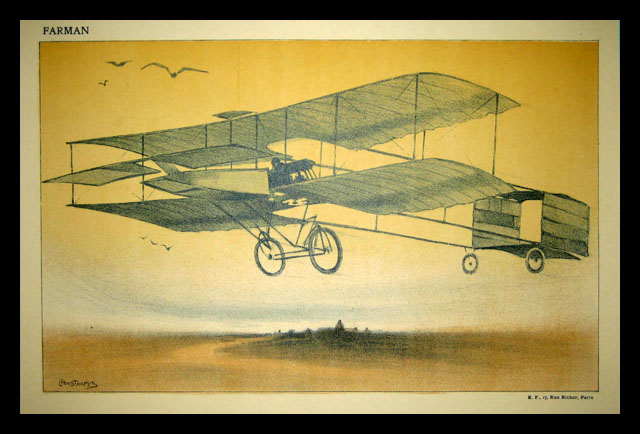
|
|
 |
Title: Farman
Description: Like many of his fellow pilots, such as Hubert Latham, Henry Edgar Mumford Farman (1874—1958) raced automobiles before he began flying airplanes. |
While recuperating from a racing accident, Farman turned his attention to the new and exciting world of aviation. In 1907, he purchased his first powered aircraft. from the celebrated French airplane designers and brothers Gabriel and Charles Voisin. Farman was one of the first. Quickly adapting to the airplane, he almost immediately started setting records and winning prizes, beginning in the fall of 1907 in France when he stayed aloft for over a minute, the first in Europe to do so. He flew first from Issy-les-Moulineaux in the Parisian suburbs, a flying field that before long would be the world’s most renowned. On January 13, 1908, his two-circle flight over Issy would be the first circular flights in the world in a craft other than a Wright Flyer. Just forty-eight hours later, he would take the 50,000 franc Deutsch-Archdeacon (his second try) for a one-kilometer circular flight in a Voisin Farman 1 bis biplane, the first in Europe to accomplish such a feat with official witnesses. The roar of the accolades greeting his victory were in stark contrast to the quiet successes already achieved five years earlier by the Wright brothers in America. Farman’s achievements were especially significant because the French had not yet seen a demonstration of the Wrights’ plane, and thus believed that Gallic pilots had taken the definitive lead in the race to the skies. Farman also took the first ever passenger into the air when Ernest Archdeacon accompanied him up on May 29, 1908. That summer, on July 6, Farman became the first French pilot to fly continuously for over fifteen minutes, soaring over twenty kilometers in twenty minutes. Farman also pioneered the classic Gnôme rotary engine in one of his planes at the seminal Reims air show of 1909, where his rotary-equipped biplane won the Grand Prix. Although later eclipsed by the in-line and radial engines, the rotary still stood as the first significant move forward in aircraft power plants from the earliest gas engines. As well, it was Farman who created the word “aileron,” denoting the movable horizontal wing control surfaces that would replace the Wrights’ wing-warping as the preferred, and superior, method of lateral control. He introduced these control surfaces in October, 1908, when he also completed a roughly 17-mile cross-country flight. The airplane shown here is a typical Voisin Farman biplane, with the readily-identifiable box-kite tail structure being one of its significant features. Farman invented and developed numerous advances in aviation technology related to structure and control issues. He founded one of the early flight schools in 1909, then started the Farman Aviation Works in 1914, a manufacturer that rolled out over 12,000 craft for the French during World War I. Still another achievement was his twin-engined Goliath airplane that could transport up to twelve passengers. Using the Goliath, Henri (he used the French spelling of his name) and his brother Maurice created Farman Lines, an airline that would later be consolidated with others into the national line, Air France. It is difficult to overestimate Farman’s impact on aviation, whether in the area of actual flight achievements, technological developments, or commercial successes. The poster artist Pousthomis here gives us an iconic image of the early years of flight, with a classic Farman biplane rising into the air over a bucolic country landscape, accompanied by birds who were probably rather confused at this giant intruder into their realm. |
|

